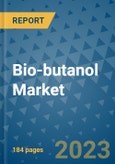Bio-butanol Market Projected to Exceed US$2 Billion by 2030, Anticipating a Strong 6.5% CAGR
The global bio-butanol market is poised for substantial growth, with a projected revenue of more than US$2 billion by the end of 2030, driven by a robust compound annual growth rate (CAGR) of 6.5% during the forecast period from 2023 to 2030.Key Market Dynamics
Bio-butanol, known for its enhanced energy density and molecular resemblance to gasoline, is emerging as a promising alternative to traditional petroleum-based fuels. The market has witnessed significant growth across various sectors, owing to its diverse applications.Key Market Insights
1. Agriculture Industry's Reliance: The agricultural sector extensively utilizes bio-butanol, primarily as food-grade solvents for food product manufacturing and extraction, especially in the production of processed foods like cheese and meat products.2. Textile Industry Adoption: The textile industry benefits from bio-butanol-based resins, which provide wrinkle resistance to materials. With increasing consumption of textile products such as clothing and apparel, this segment presents growth opportunities for the industry.
3. Raw Material Trends: Cereal crops, including wheat, corn, sugar, and others, dominated the raw material market for bio-butanol in 2022. These crops are essential in the formulation of bio-based butanol and contribute to improved cereal production.
4. Acrylates in Demand: The global acrylates application segment is expected to maintain a dominant role during the forecast period. Acrylates find diverse applications across industries such as paints, coatings, textiles, and lubricants.
5. Transportation Sector Growth: The transportation sector is positioned for strong growth due to the increasing demand for eco-friendly and sustainable transportation fuels. This trend aligns with the rising focus on energy security and independence.
6. Regional Dominance: Asia Pacific leads the bio-butanol market, driven by significant economies like China, a major producer of paints and automobiles. North America follows due to factors such as its expanding population and government investments in renewable energy sources.
Comparative Analysis
The global auto manufacturing sector has thrived due to increased logistics and transportation activity, alongside well-established manufacturing facilities. For example, the Indian auto components aftermarket is expected to witness a 10.5% growth rate, reaching US$13 billion by 2019-20, up from US$8.4 billion in 2016-17, as reported in September 2022.Bio-based butanol finds widespread use across various end-use industries, including oil and gas, transportation, consumer goods, and automobiles. The market has been influenced by factors such as the availability of raw materials and the versatility of bio-butanol across multiple sectors.
Growing construction activities have led to increased usage of acrylates and plasticizers derived from bio-butanol. Plasticizers enhance cement quality, while acrylates are employed in manufacturing lightweight and shatter-resistant window panels, replacing glass. The construction industry's growth in emerging economies supports bio-butanol's applications.
Governments worldwide are focusing on economic growth by improving infrastructure to attract foreign investments and tourism. Such investments drive demand for paints and other biotech industry products, further boosting the bio-butanol market.
The adoption of biofuels to reduce reliance on fossil fuels and decrease greenhouse gas emissions has been encouraged by governments globally. Regulations and directives, such as the Renewable Energy Directive in Europe and the Renewable Fuel Standard in the United States, are driving demand for bio-butanol as a renewable energy source.
Key Trends and Opportunities
1. Research and Development Focus: R&D efforts aimed at improving production processes and reducing biobutanol production costs drive market growth. Technological advancements are expected to enhance production efficiency and competitiveness.2. Sustainable Fuel Adoption: Increasing environmental concerns boost demand for bio-butanol as a cleaner and more sustainable fuel, with applications in transportation, aviation, and power generation.
3. Lignocellulosic Biomass: The utilization of lignocellulosic biomass for bio-butanol production offers economic advantages and environmental benefits, addressing concerns related to agricultural and forestry waste.
Regional Overview
1. Asia Pacific Leads the Global Market: Asia Pacific holds the largest market share in the bio-butanol market, driven by key end-users like the automotive and construction industries in major manufacturing nations such as China, India, Japan, and South Korea.2. North America Maintains Strong Position: North America is expected to continue dominating the market during the forecast period. Factors such as population growth, expansion of the chemical manufacturing sector, and government investments in renewable energy sources contribute to market growth.
Competitive Landscape
The global bio-butanol market is consolidated, with a few major players leading the industry. These key players are introducing new products and expanding their distribution channels to strengthen their global presence. The market is anticipated to witness further consolidation in the coming years.Leading Companies in the Global Bio-butanol Market
1. Abengoa2. Biocleave Limited
3. Bioenergy International
4. Butalco GmBH (Lesaffre)
5. Butamax Advanced Biofuels LLC (BP and Corteva)
6. Celtic Renewables
7. Cathay Industrial Biotech
8. Eastman Chemical Company
9. Gevo Inc.
10. Green Biologics
11. Metabolic Explorer SA
12. Phytonix
13. Solvay S.A.
14. W2 Energy Inc.
15. PetroChina
This product will be delivered within 1-3 business days.
Table of Contents
1. Executive Summary
2. Market Overview
3. Global Bio-butanol Market Outlook, 2018 - 2030
4. North America Bio-butanol Market Outlook, 2018 - 2030
5. Europe Bio-butanol Market Outlook, 2018 - 2030
6. Asia Pacific Bio-butanol Market Outlook, 2018 - 2030
7. Latin America Bio-butanol Market Outlook, 2018 - 2030
8. Middle East & Africa Bio-butanol Market Outlook, 2018 - 2030
9. Competitive Landscape
10. Appendix
Companies Mentioned
- Abengoa
- Biocleave Limited
- Bioenergy International
- Butalco GmBH (Lesaffre)
- Butamax Advanced Biofuels LLC (BP and Corteva)
- Celtic Renewables
- Cathay Industrial Biotech
- Eastman Chemical Company
- Gevo Inc.
- Green Biologics
- Metabolic Explorer SA
- Phytonix
- Solvay S.A.
- W2 Energy Inc.
- PetroChina
Methodology

LOADING...








